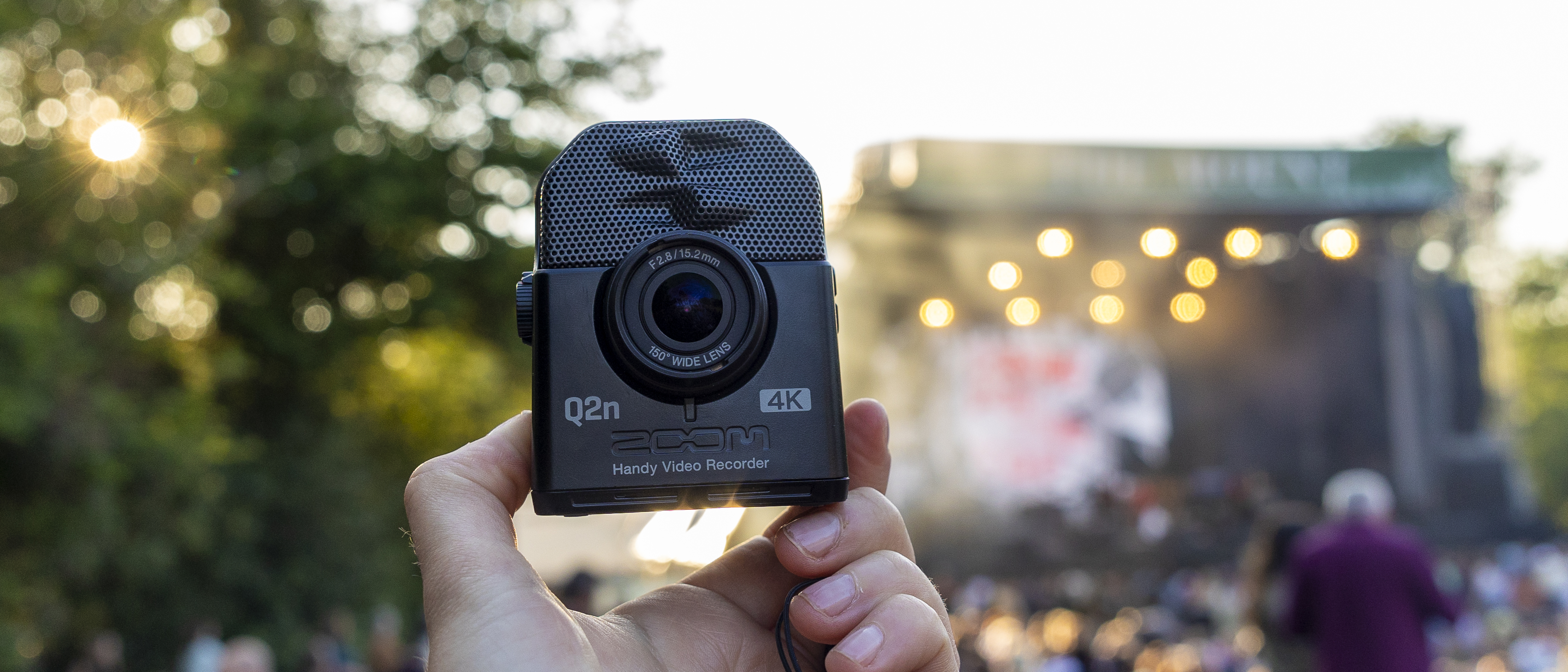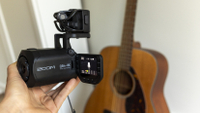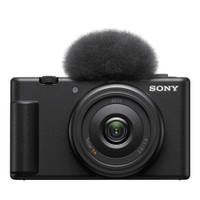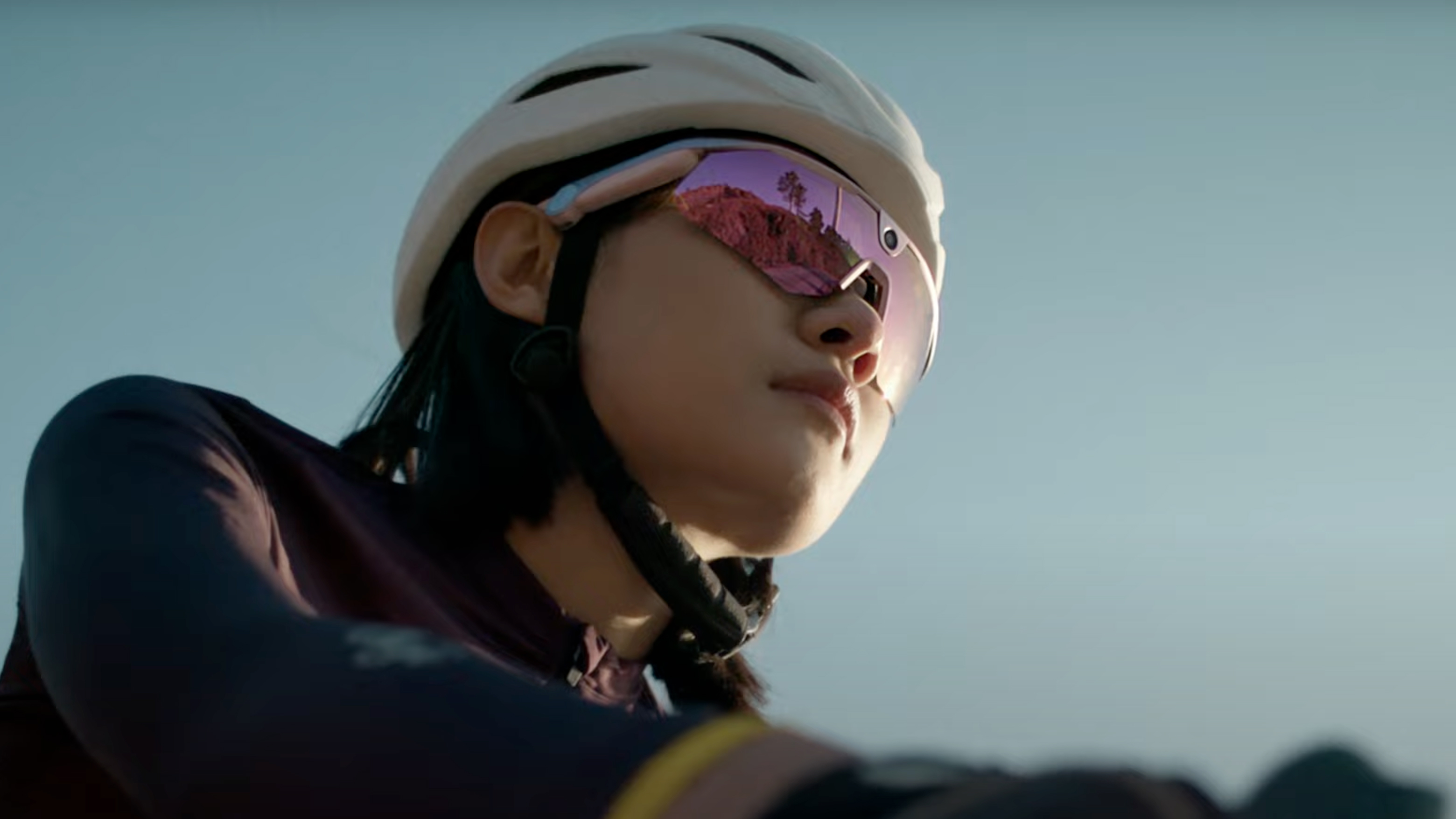Digital Camera World Verdict
The Zoom Q2n-4K is billed as a 4K camera for musicians, and its X/Y stereo microphones offer much better audio quality than the visuals. This unique recorder is dinky and easy to carry, but I found the battery life wanting and the video quality grainy in anything but bright light. Still, it's a great budget choice for music teachers, YouTubers, and musicians and can handle live streaming lessons, band rehearsals and jams, and clips from festivals and gigs.
Pros
- +
Easy to operate
- +
Cute, take-anywhere size
- +
Brilliant audio recorder
Cons
- -
Eats up AA batteries
- -
No stabilization
- -
Poor LCD screen
Why you can trust Digital Camera World
Zoom has been making portable sound recorders – known as "handy" recorders – for decades. Beloved by videographers and filmmakers, the company has also been a major innovator in the music space, launching multi-effect processors for guitar straps, iPhone microphones, and more recently in a world where everyone seems to have a podcast, podcast recorders.
One of Zoom's latest novel releases is the Zoom Q2n-4K, a palm-sized video recorder aimed squarely at musicians and users wanting to share their music online. It's an adorably small device, with a wide-angle lens on one side, an LCD screen on the back, and a wraparound microphone design incorporating an X/Y stereo array. It can function as a standalone webcam and audio recorder, making it an incredibly versatile product for music teachers and YouTubers equally.
Of course, you might ask yourself – and I have done – why not just get one of Zoom's best audio recorders and pair it with your smartphone, or one the best cameras for vlogging with a decent microphone? There are two reasons. Firstly, Zoom is known for its audio quality, and its handheld devices can capture a wide range of sounds and environments brilliantly with minimal training or setup required.
Adding a camera to the mix with the Q2n-4K, Zoom has created a convenient all-in-one without trailing wires or moving parts. Secondly, at around $200, the Zoom Q2n-4K is affordable for music students, musicians breaking into the industry, or those building up a following online.
The Zoom Q2n-4K is cheaper than the Zoom Q8n-4K I've previously tested, but that offers 4-track audio, XLR-mic inputs, plus a rechargeable battery to bring it in line with vlogging rivals.
The Q2n-4K is affordable, for sure, but does it offer the quality that its target market needs? I've always been pleased with the build and audio quality of Zoom products but found their usability more varied. I tried the Q2n-4K for several weeks to discover whether it was a livestreaming dream or a musician's nightmare. Read on to find out whether it's the right handy recorder for you.
Zoom Q2n-4K: Specification
| Sensor | 16MP, 1/2.3-inch |
| Lens | 150° wide-angle (f2.8/15.2 mm) |
| Video format | MPEG-4 AVC/H.264 (MOV) |
| Video resolutions | 4K: 30/25/24p, 1080: 60/50/30/25/24p, 720: 30/25p |
| Audio formats (WAV) | 96 kHz/24-bit, 48 kHz/24-bit, 44.1 kHz/16-bit |
| Audio inputs | Stereo input |
| Memory card | microSDHC/microSDXC (class 10 or higher, 256 GB ma) |
Zoom Q2n-4K: Price
Considering its compact size and feature set, the Q2n-4K delivers excellent value at around $200/£200. It's a more budget-friendly option compared to the Q8n-4K, which makes sense as it sacrifices some audio capabilities, recording in stereo only, and lacking XLR microphone ports for professional setups.
What lets down this handy recorder is its reliance on two AA batteries for power. These weren't included with my sample, so unless you have rechargeable AA batteries, you'll have to factor in the cost of buying and replacing them. I found frequent replacements were necessary, so this will be an ongoing expense unless you plan to power the camera from your computer (with a cable also sold separately).
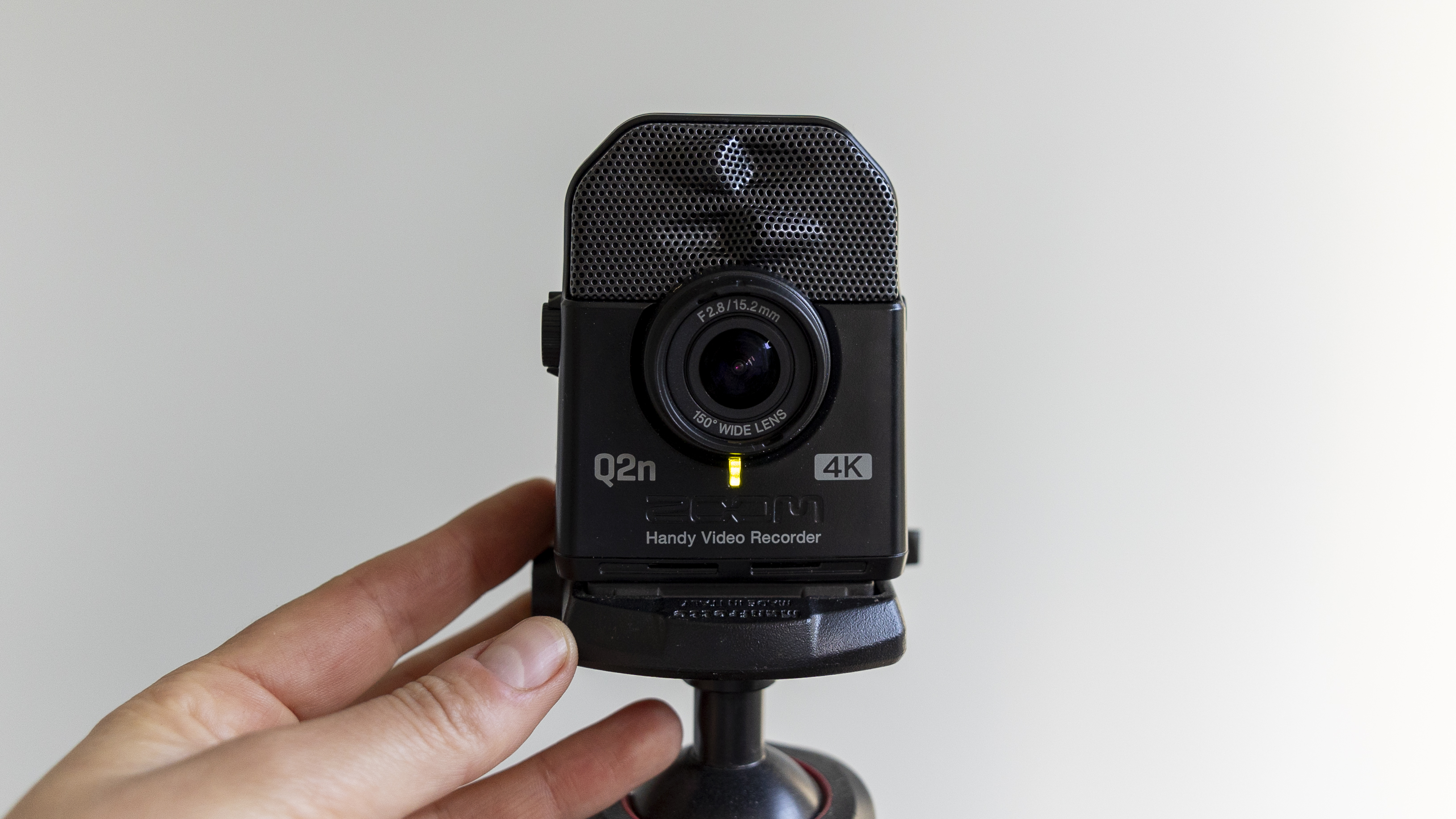
Zoom Q2n-4K: Design & Handling
The Zoom Q2n-4K looks nothing like the Zoom Q8n-4K, and that's a good thing as it's designed to be more portable. In fact, it doesn't look like any camera I've tried before, but that doesn't mean it's hard to use. On the front is the 15-degree wide-angle lens and a handy light to indicate when you're recording (it turns red when you are). You also get a lens cap for protection and a tiny lens hood to block out flare in sunshine or bright studio lights.
On one side, there's a headphone jack – always important for checking audio levels – an external input, and volume buttons for the headphones. Flip the camera around and there's a small dial for controlling the microphone level, plus micro USB and mini HDMI ports. I'm surprised that in 2024 we haven't got a USB-C port instead, both for charging the camera and connecting it to a computer. My iMac only has USB-C ports, so I had to get an adapter just to connect it.
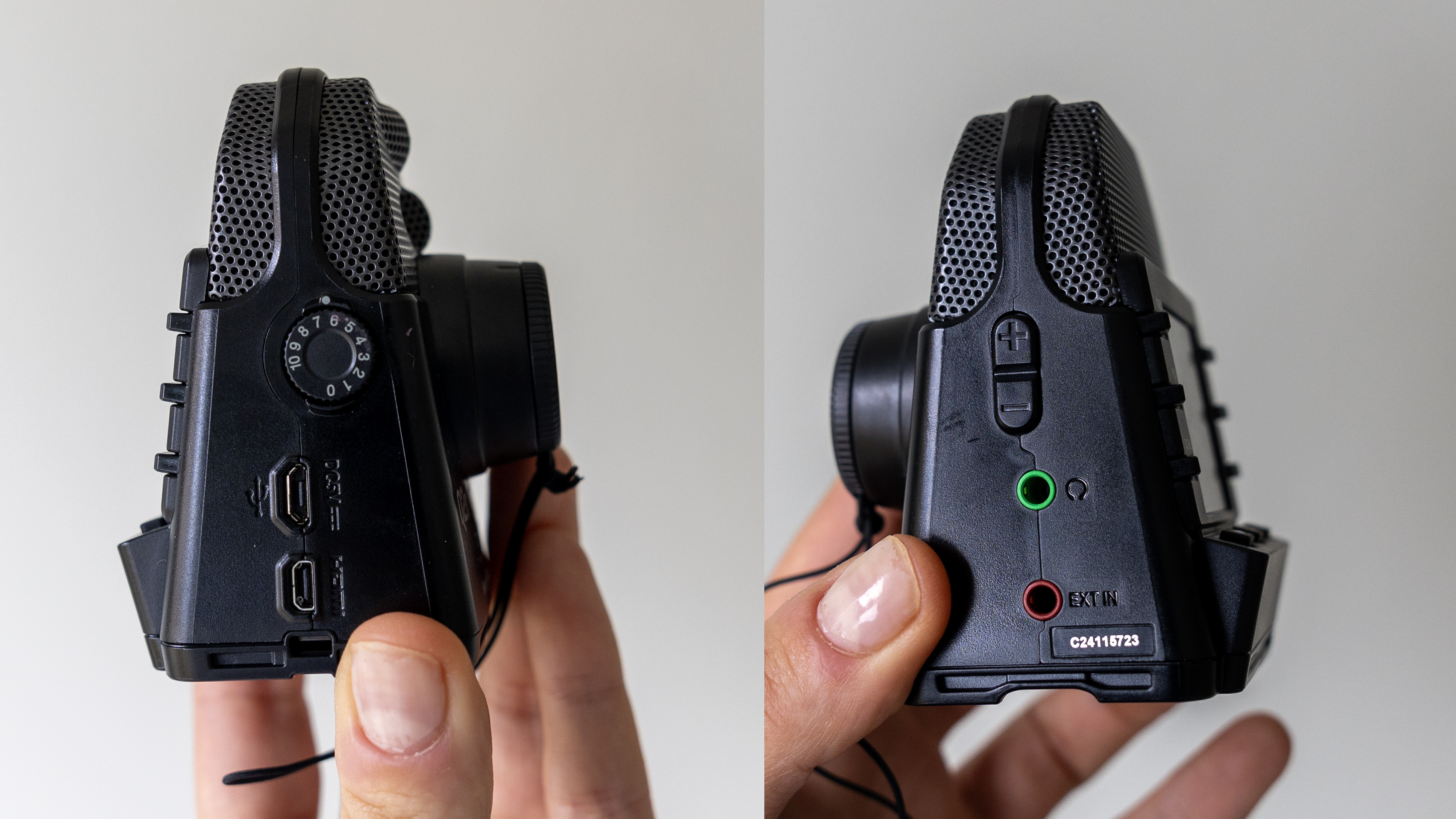
What I liked most about the Zoom Q2n-4K was its ease of use. At the back of the camera, there's a 1.77-inch four-color LCD (160 × 128 resolution) for viewing the scene and menu settings, while nine buttons aid handling, as the screen isn't touch-sensitive. It only takes a few hours of use to remember what these buttons do, although I'd love them to be slightly more responsive when pressed.
Underneath the screen is a power/play button, an obvious red record button, and a button for exit/settings. You also get physical buttons for tweaking the field of view between five settings, the video quality (or setting audio only), the scene type (there are twelve, including outdoor, sunset, monochrome, and film), Lo Cut, the audio quality, and auto gain. A camera like this is designed to be used quickly, and I love that almost everything you need can be accessed without having to dig into the menu, which themselves are still clear and accessible.

Given that the LCD screen doesn't articulate in the same way as the Q8n-4K for forward-facing shots, it's hard to know when you're in the frame when you're filming yourself. There were many takes where I was filming myself for a few seconds with the camera on a tripod, reviewing it back, and then moving around to improve my positioning.
One advantage is that the light on the front of the camera goes red to tell you you're recording. There's no remote or timer delay function built into the system to start recording, so you have to start the camera and get into position, which adds editing time to your footage and could make your live streams a bit janky.
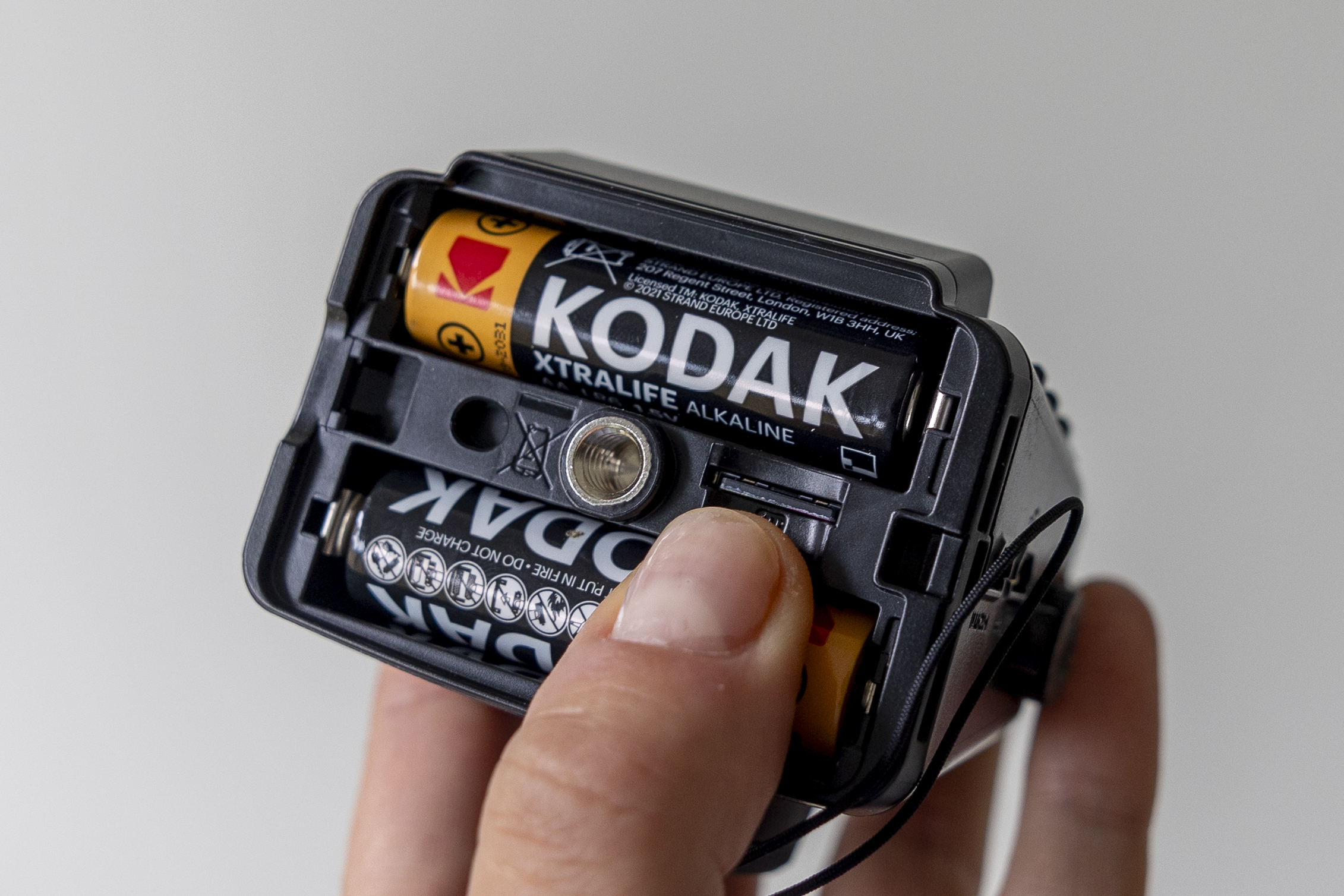
You access the battery and memory card slot by unclipping the plastic cover underneath the Zoom Q2n-4K. It's a MicroSD card, a size which I assume was chosen to keep the size down, and while the two AA batteries were easy to slot in, the card slot was a slight paint point for me. There's no spring mechanism, making it difficult to remove. When I wanted to take the card out to transfer the footage to my Mac, I had to prise it with my nails or tweezers. This is fiddly and makes you worry you'll cause damage.
Zoom Q2n-4K: Performance
Overall, I'm impressed with the performance of the Zoom Q2n-4K, for its price bracket, and I think musicians will find a lot to love about the audio quality. Thanks to the camera's three WAV audio formats (96 kHz/24-bit, 48 kHz/24-bit, 44.1 kHz/16-bit) you can tailor the quality and size of files to your project's needs. And using “Camera Off” mode opens up the Q2n-4K to become a handy recorder in its own right, or to replace your computer mic if you so wish.
I found it easy to monitor the audio output levels using headphones with the stereo output jack or to glance at the levels on the LCD screen and see when they were peaking too high. I mainly recorded in 98kHz/24-bit during testing and loved the well-balanced, rich tone, whether at home, in a field at a festival, or in an echoey conference room. I noticed that setting the microphone to auto-gain (you've got the chance of concert, solo, or meeting here) left some of my recordings on the quiet side, but then the Zoom Q2n-4K handles loud music so well I don't mind this.
The X/Y mics within the recorder sound great. I did a test recording at a loud folk music night, and not only was my voice clear, but the three different instruments could be heard clearly and evenly. The Q2n-4K handles bass notes well, giving them a rounded sound even at low or extreme volumes. The recorder also performs well as a USB mic, much better than my iMac's in-built microphone and rivaling the pro-grade Sennheiser mic I usually have plugged in.
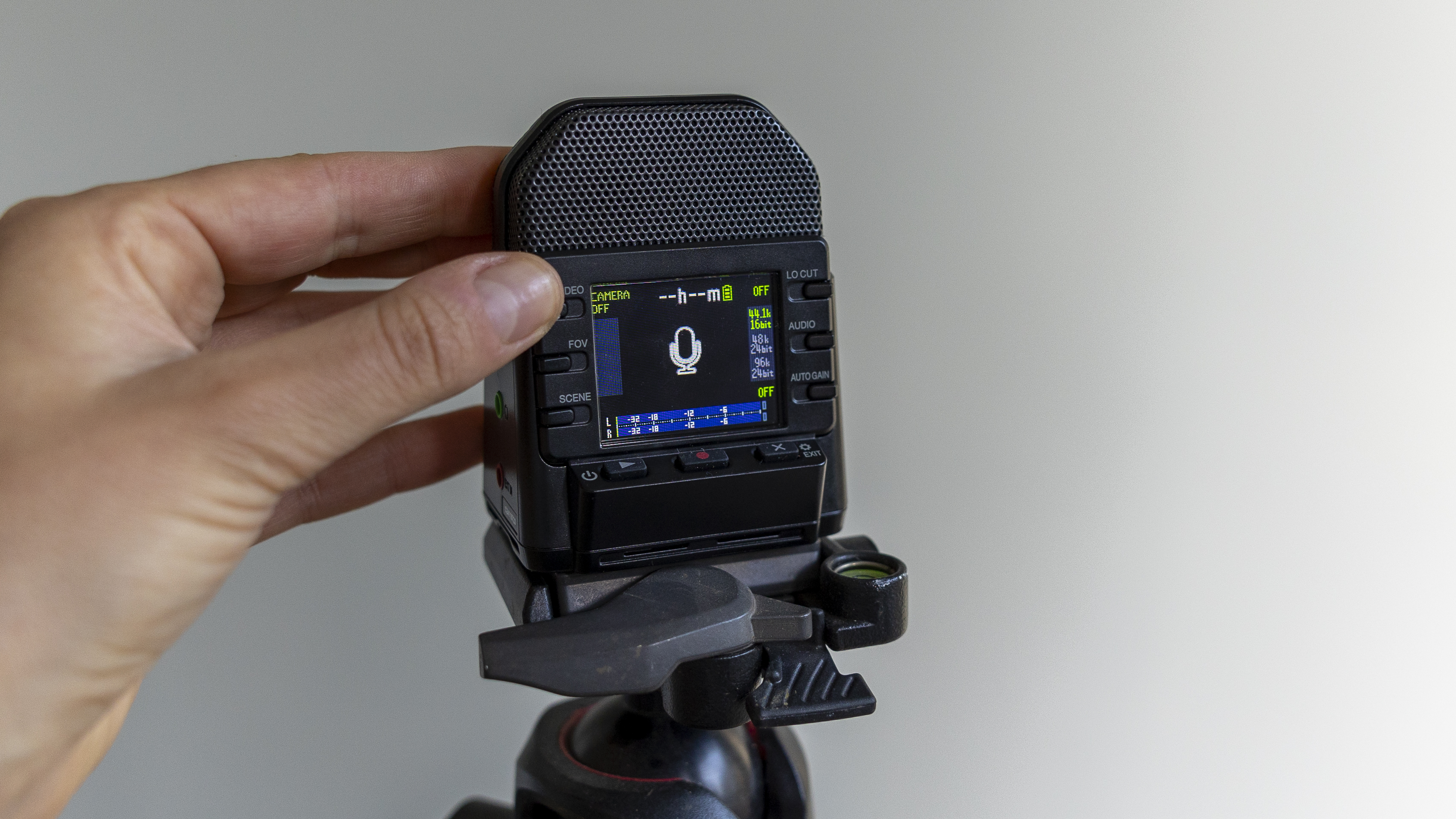
If I were to sum up this review in a sentence it'd be; audio great, video not so great. Even at the maximum 4K resolution, the Zoom Q2n-4K's video is serviceable, but nowhere near as good as my iPhone or even my GoPro from a few years back. In anything but bright sunshine, the small camera sensor produced footage with muddy shadows and a noisy picture overall. By their nature, music settings are often low-light environments, so it's a shame that the Zoom Q2n-4K struggled so much with detail and color here. I'd recommend that musicians keep the room as well-lit as possible when recording.
Having five steps for changing the field of view, rather than a rolling ability to zoom in and out of your chosen subject, means you’re limited somewhat by the framing options. If you press the field of view button to toggle through zoom levels during filming it's also very audible, and hard to remove in post. The video quality degrades the further you zoom in, as the camera crops in on the image rather than relying on a physical lens zoom.
The Q2n-4K was designed to take in performances on a tripod or stable platform and it excels at that. It doesn't feature built-in stabilization, which is something to bear in mind if you want any freedom of movement while filming, or to get handheld footage at a live show. The footage becomes incredibly shaky when you try shooting vlog-style videos and if you're that type of music YouTuber you may want to look elsewhere.
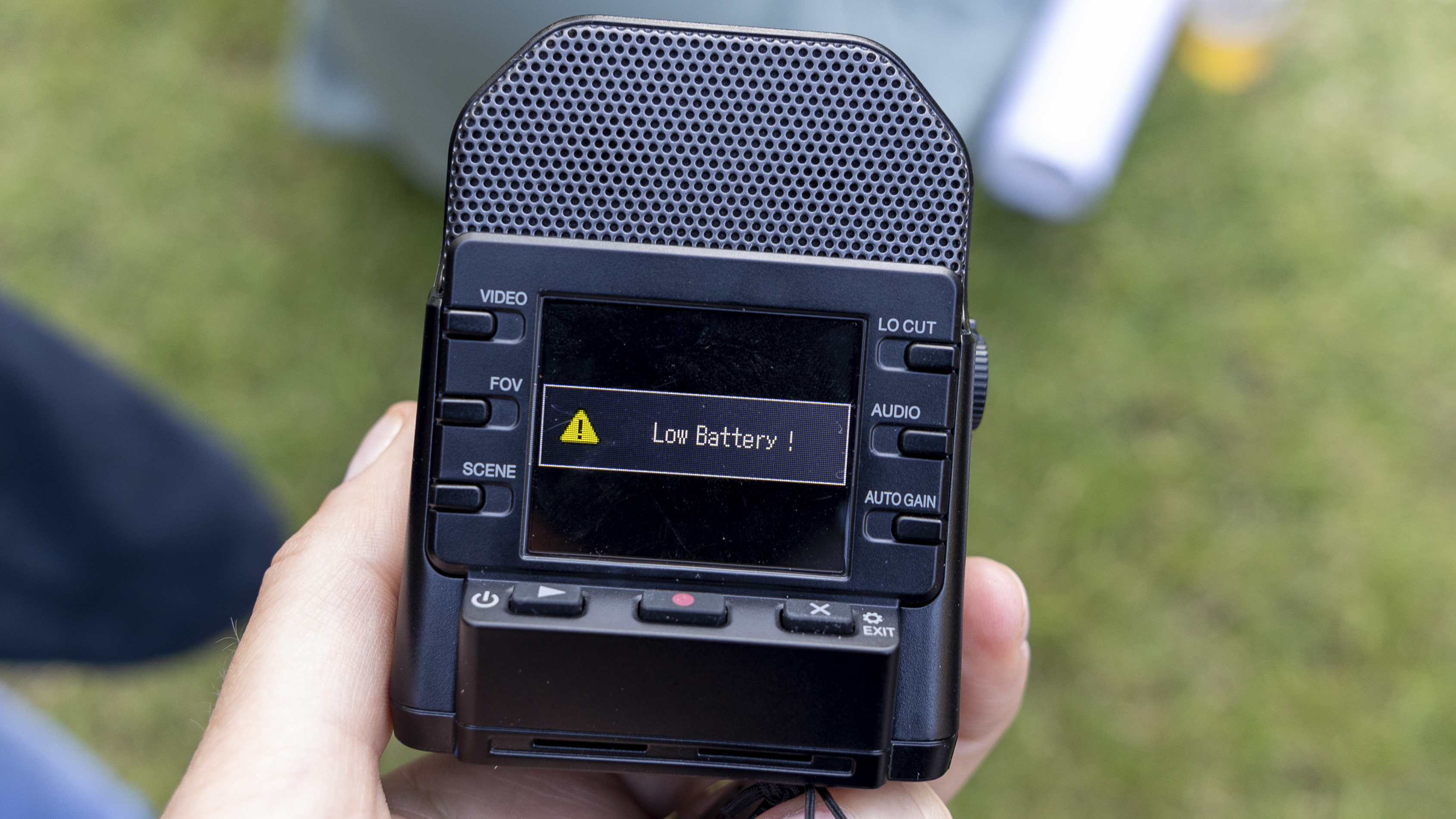
Given that the Zoom Q2n-4K comes at such an affordable price point, I can live without Bluetooth or WiFi, or a remote control to start recording. But its biggest downside is the battery life and power source. One set of AA batteries lasted me less than an hour of recording time, and I felt I was constantly replacing them during filming. For one live music event, I'd checked the battery before leaving home and it showed two-thirds full. Unfortunately, when I started recording, the camera only lasted a few minutes before dying completely, meaning I missed capturing footage of my favorite teenage artists. There are two lessons here: always pack spares and ensure the camera can't turn on in your bag.
Of course, at home or in a studio you can power the camera via micro-USB when it's used as a webcam (why not USB-C?). And if you buy the Zoom BCQ2n battery case Q2n-4K, which takes four AA batteries, you can significantly expand the camera's battery life for field work and live gigs without a power outlet.
Zoom Q2n-4K: Sample video
Above: sample video show with the Zoom Q2n-4K
I had the Zoom Q2n-4K for a few weeks, testing it for recording sessions at home (a keyboard and guitar, and my rusty playing skills), live gigs, folk performances, and some spoken word. Unfortunately on several opportunities to record, the battery was lower than displayed and the camera ran out of power before I could get any decent clips.
Zoom Q2n-4K: Verdict
The Zoom Q2n-4K is a great choice if good sound is more important than good video, and you have about $200/£200 to spend. I'm not a professional musician, but I do play several instruments, get incredibly hung up on audio quality, and have a ton of experience using microphones for filmmaking. While the Zoom Q2n-4K feels a bit dated in terms of video performance and lags behind the best camera phones, the clarity and richness of its sound make up for that.
Although there's no video stabilization, it's easy enough to pop the Q2n-4K on a cheap mini tripod to keep the footage nice and stable. The fact, that you can pop the Q2n-4K in your pocket, then whip it out and get usable clips in seconds is fantastic. The automated nature of the camera means that even those new to recording themselves should get decent results, but there are enough audio options for budding audiophiles too.
The recorder isn't marketing itself as an advanced broadcast-level device. Instead, its size and convenience make it perfect for musicians wanting to capture clips and quick videos on the go, when they don't have the budget for pro gear – or the desire to carry it around. I found it could handle everything from jazz to folk to heavy metal in the car, and still produce a rich, well-balanced tone.
I've loved using the Q2n-4K to get back into keyboard and guitar playing, grabbing snippets at gigs, and recording vocals for video projects. It's just not going to be my recorder of choice until Zoom swaps those AA batteries for a rechargeable, sustainable option.
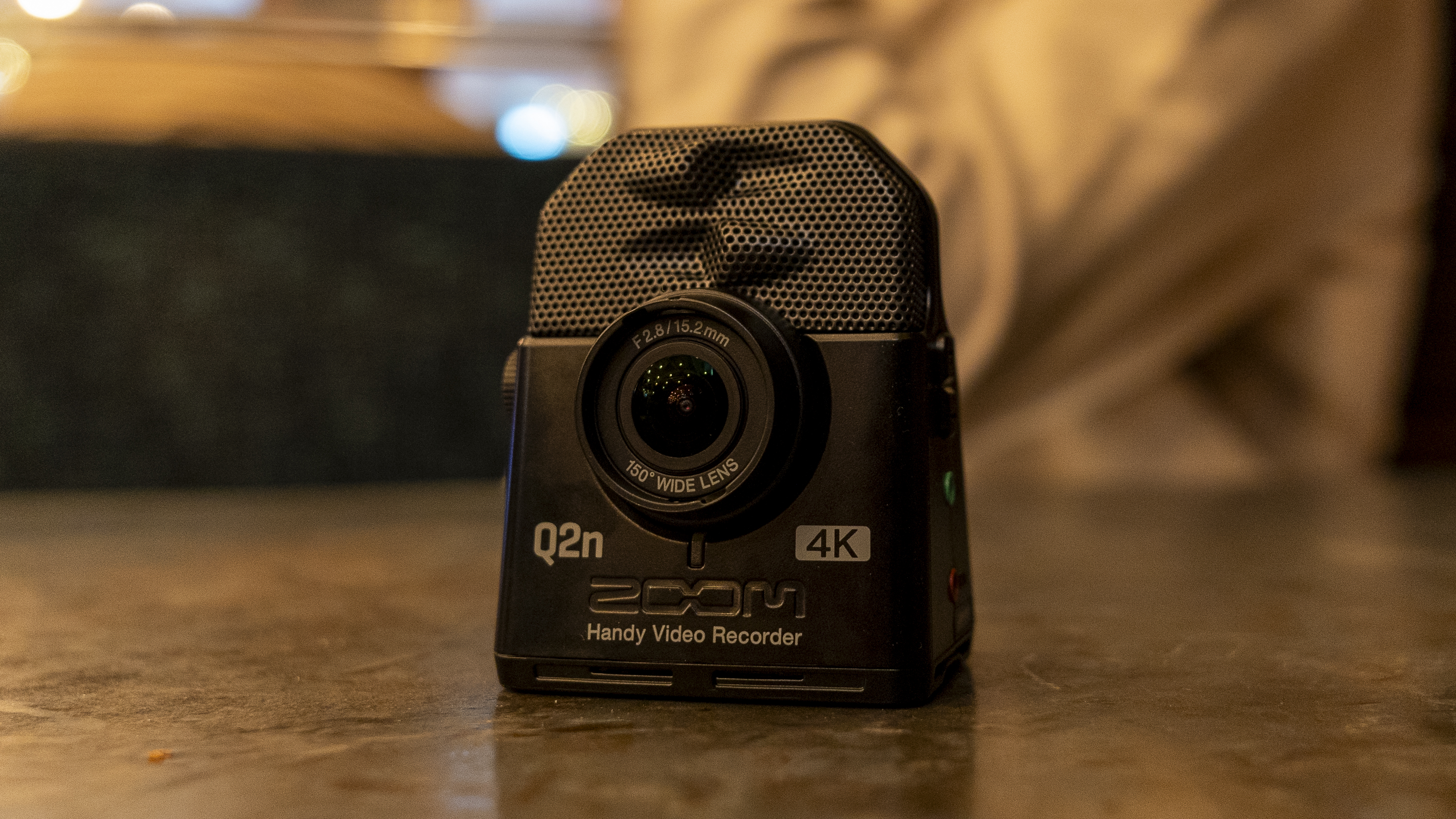
✅ Buy this if...
- You're just starting to record your music for a new channel.
- You want reliably good sound in an all-in-one recorder.
🚫 Don't buy this if...
- You don't want to keep buying new AA batteries.
- You want video quality good enough for a modern social audience.
Zoom Q2n-4K: Alternatives
Zoom Q8n-4K
The Q8N-4K is Zoom's more advanced choice for musicians, offering better handling with a flip-out screen. You also get two XLR mic inputs for up to four-track recording, but it's around double the price of the Q2n-4K.
Sony ZV-1F
Sony's cheapest vlogging camera has a flip-out screen and built-in stabilization, making it a better choice for move-about music YouTubing. It's more expensive than the Zoom Q2n-4K though, and you'll need a decent external mic for the same level of audio quality.

Lauren is a writer, reviewer, and photographer with ten years of experience in the camera industry. She's the former Managing Editor of Digital Camera World, and previously served as Editor of Digital Photographer magazine, Technique editor for PhotoPlus: The Canon Magazine, and Deputy Editor of our sister publication, Digital Camera Magazine. An experienced journalist and freelance photographer, Lauren also has bylines at Tech Radar, Space.com, Canon Europe, PCGamesN, T3, Stuff, and British Airways' in-flight magazine. When she's not testing gear for DCW, she's probably in the kitchen testing yet another new curry recipe or walking in the Cotswolds with her Flat-coated Retriever.
